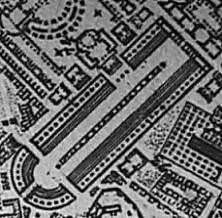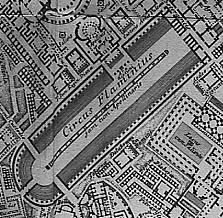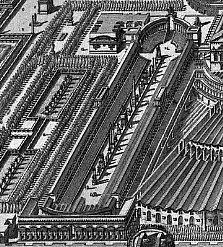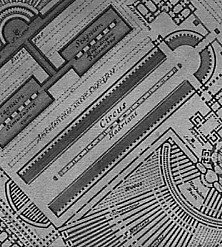another Piranesian daze
2000.05.16
...went back to again scan the Ichnographia Campus Martius, and just as I'd begun to suspect, all the circuses within the Ichnographia show a change of plan. ...the circuses of the Ichnographia in its common version are more archeologically correct.) ...the circuses of Hadrian and Domitiae as represented in the frontispiece comply with the "uncommon" circus plans...
The place where the bodies of the dead were burned and buried under Hadrian
2001.07.18
back to the Campo Marzio
2001.09.08 16:50
Hello John,
...getting back to the two states of the Ichnographia, here are some further thoughts and questions:
1. I believe the first state is the plan as it is NOT published in books today. If you look at the smaller and earlier plans of the Campo Marzio within the plates prior to the Ichnographia, you will see earlier plans of the Circus Flaminius the same as the Circus Flaminus plan within the first state Ichnographia. Furthermore, the aerial view the Circus Hadriani within the frontispiece corresponds in plan with the first state Ichnographia.
 
 
2. I think the circus delineations of the second state (which are all virtually identical to each other) are in fact delineations based on the Circus of Maxentius (rather than the Circus Maximus). This is somewhat significant in that (according to my research and interpretation of the Ichnographia as a double narrative relating Rome's inversion from pagan city to Christian city) Maxentius is exactly the ruler of Rome immediately prior to Constantine's Chistian efforts.
3. ...now knowledgable of the practice of damnatio memoriae, I wonder if Piranesi purposefully 'erased' portions of the Ichnographia as a reenactment of the damnatio memoriae practice, and, like some extant examples of dm inscriptions, if he then purposefully followed up with a palimpsest (of another plan) over the erasure.
4. I realized that I have yet to see an actual print version of the second state of the Ichnographia. All I've ever seen is an actual first state (1761) version. Do you know if you've seen an actual eighteenth cent. print version of the second state? Moreover, did you happen to make a trip to Rome to see which state the actual engraved plates are in? It is the current state of the plates that would surely identify the second state (that is, unless someone long ago altered a reproduction, and it happens to be an altered reproduction that's been printed in books all these years).
5. I also believe that it was indeed Piranesi that made the changes. My main reasoning here is that Piranesi was very likely the only person that could have made the changes with such dexterity.
As to Tafuri, I have documented so many cases within the Ichnographia that carried explicit meaning and message on Piranesi's part, that all of Tafuri's theorizing that the Ichnographia is indicative of and/or percursor to the modern meaninglessness of architectural form is plainly and emphatically wrong. What Tafuri obviouly never did, but definitely should have done, is to translate all the Latin labels that Piranesi applies to virtually all the plans of the Ichnographia. It is only through reading the labels and the planimetrics in combination that the full meaning of Piranesi's Campo Marzio comes through.
All the best,
Steve Lauf
| |
Krautheimer and Johnson
2005.07.07 15:23
It just never occurred to him before that the Mausoleum of Romulus/Circus of Maxentius complex (which reenacts the almost two hundred years earlier Mausoleum of Hadrian/Circus of Hadrian complex) became the paradigm, albeit inverted, for all the Roman Christian "church" architecture immediately after the Basilica Constantiniani (St. John Lateran) and the Basilica San Pietro Vaticano. That aerial shot of the Mausoleum of Constantina (Santa Costanza) adjacent the circus-like dining hall first "basilica" of St. Agnes made it all so clear. If only the circus-like dining hall first "basilica" of Sts. Pietro and Marcellinus adjacent the Mausoleum of Helena were still to be seen from the air. How clever of Eutropia and Helena to invert the pagan 'munus' architecture into Christian 'munus' architecture, and how very clever of Piranesi to secretly hide all this architectural history information within the ever quaestio abstrusa Ichnographia Campi Martii.
|